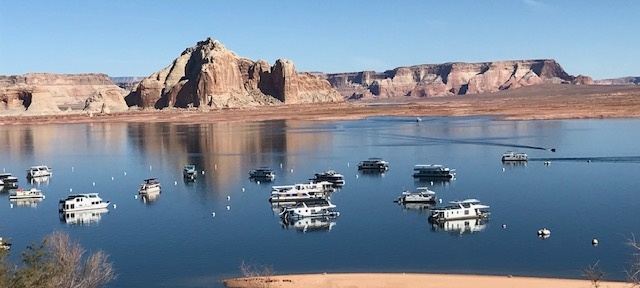Wayne’s fishing report is back!
September 15, 2021
3548 above sea level
Water temperature 78-81 F.
By Wayne Gustaveson
Lake Powell’s water level is now at 3548 MSL and has dropped only 2 feet since August 26th. I am grateful for the upstream reservoirs that have increased their outflow to keep Lake Powell as full as possible during these drastic times of water scarcity. Increased releases of water from the Flaming Gorge Reservoir on the Utah-Wyoming border have begun and will continue through October. The releases from the Blue Mesa Reservoir in Colorado are expected to occur from August through October. Navajo Lake, which spans the Colorado and New Mexico border, will increase releases in November and December. The releases will result in an additional 4 foot drop in Flaming Gorge, 2 feet in Navajo, and 8 feet in Blue Mesa. Hopefully there will be a heavy blanket of snow this winter to replenish all of the reservoirs mentioned.
Since the lake has dropped only 2 feet, there are ramps at Wahweap and Bullfrog that are still in operation. The Wahweap auxiliary ramp provides access to the boat while the legacy ramp is awaited to open in the near future. Thanks to the National Park Service for maintaining the old ramps and remodeling the old ramps that will now reappear if the water continues to sink.
The surface water temperature drops, which allows all the fish in Lake Powell to improve their eating habits. Smaller fish are able to handle warm surface water to a depth of 30 feet much better than larger adults. Adult perch, strippers and pikeperch stay at a depth of 12 m and deeper, where the water is cooler. Fishing has been slow for most fish species due to the warm water and lack of food. Shad numbers are lower than usual. When the water cools down in late September and October, fishing for the entire length of the lake will improve.
Expect to bait stripers on the dam and in most of the canyons this week. Drop anchovies to 20-30 feet to catch small striped fish, which are the healthiest fish right now. In addition to feeding on bait and small fish, they can also eat plankton to keep their bodies in shape. Larger stripers last at 40-60 feet. They also eat anchovies regularly. Unfortunately, the larger adult fish have to stay in deeper water where there is much less food. These fish are still fun to catch, but they don’t offer the same excellent foods as the small fish. The best striper boil review comes from Bullfrog Bay, where the smaller stripers (6-14 inches) pop up for quick boil most days.
Fishing for perch and pikeperch is slow. These fish stick to deeper water to keep cool. Most anglers generally fish shallow rocky coasts to catch perch. The secret now is to fish deeper water (25-45 feet) to catch perch. Largemouth bass feed in open water as there is no brush at all in these low water situations.
If you are planning a fishing trip this fall, pay attention to the water temperature to pick the right time. Remember, perch spawn in the spring when the temperature is in the low 60s. Fishing for them in the fall is best in the same range of 60-65 degrees.
I wish you all a great winter with huge snow banks that all melt at the same time in spring and fill the lakes, rivers and reservoirs. That would be the best fishing Christmas present in 2022.



Comments are closed.